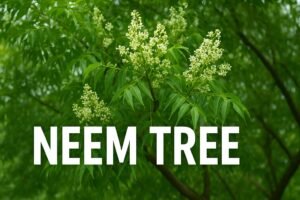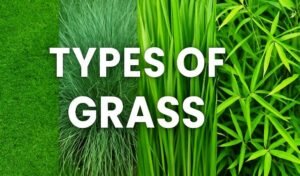Grass is one of the most common and important plant types on Earth. It plays a key role in agriculture, landscaping, sports fields, lawns, and wildlife habitats. There are thousands Types of Grass Species found around the world, each with unique features and uses.

Major Categories of Grass
Grasses are usually divided into two main types based on climate:
1. Cool-Season Grasses
Grow best in cool climates (15°C to 25°C) and stay green in spring and fall.
Examples:
| Grass Type | Scientific Name | Common Use |
|---|---|---|
| Kentucky Bluegrass | Poa pratensis | Lawns, parks, sports fields |
| Ryegrass | Lolium perenne | Golf courses, quick-growing lawns |
| Fescue | Festuca spp. | Shade-tolerant lawns, pastures |
| Bentgrass | Agrostis spp. | Golf greens |
2. Warm-Season Grasses
Grow best in hot climates (27°C to 35°C) and are drought-resistant.
Examples:
| Grass Type | Scientific Name | Common Use |
|---|---|---|
| Bermuda Grass | Cynodon dactylon | Lawns, cricket & football fields |
| Zoysia Grass | Zoysia japonica | Heat-tolerant lawns |
| St. Augustine Grass | Stenotaphrum secundatum | Coastal regions, lawns |
| Buffalo Grass | Bouteloua dactyloides | Low-maintenance turf |
Common Types of Grass in India
| Grass Name | Local/Scientific Name | Use |
|---|---|---|
| Doob Grass | Cynodon dactylon (Durva) | Lawns, medicinal, religious |
| Napier Grass | Pennisetum purpureum | Cattle fodder |
| Vetiver | Chrysopogon zizanioides (Khus) | Aromatic roots, soil erosion control |
| Lemon Grass | Cymbopogon citratus | Herbal tea, oil extraction |
| Bamboo Grass | Bambusoideae | Construction, crafts |
| Palmarosa Grass | Cymbopogon martinii | Essential oil, perfumery |
Uses of Grass
- Lawns & Landscaping – Grass is the base of parks, gardens, and green spaces.
- Fodder – Many grasses are used as animal feed.
- Soil Erosion Control – Grasses bind soil and prevent landslides or erosion.
- Air Purification – Grasses improve air quality and act as natural coolants.
- Medicinal – Some grasses like durva and vetiver have health benefits.
- Cultural & Religious Use – Doob grass is sacred in Hindu rituals.
Grass for Animal Feed (Fodder)
| Grass Name | Benefits |
|---|---|
| Napier | Fast-growing, rich in nutrients |
| Guinea Grass | High in protein for dairy animals |
| Hybrid Bajra Napier | High yield, suitable for dry areas |
| Para Grass | Suitable for wetland feeding |
| Sudan Grass | Drought-resistant, quick regrowth |
Tips for Choosing Grass for Your Land
- Climate – Choose cool or warm-season grass based on your region.
- Sunlight – Some grass needs full sun, while others grow in shade.
- Soil Type – Test your soil before planting grass.
- Water Needs – Select drought-resistant types for dry regions.
- Use Purpose – Lawns, grazing, erosion control, or aesthetics?
Conclusion
From tiny lawns to vast grazing lands, grass is everywhere—quietly supporting life and ecosystems. Whether you’re planning a garden, conserving wildlife, or raising livestock, selecting the right grass type is essential.
🌐 Explore more natural wonders on www.wildlifenest.com
Want to know about grasslands, grazing species, or wild habitats? Stay connected!
FAQs – Types of Grass
1. How many types of grass are there in the world?
There are over 10,000 species of grasses worldwide. These include lawn grasses, fodder grasses, wild grasses, and ornamental types.
2. Which type of grass is best for lawns in India?
Doob grass (Cynodon dactylon) and Bermuda grass are best for Indian lawns. They are drought-tolerant, fast-growing, and provide a green, soft carpet-like feel.
3. What is the difference between cool-season and warm-season grasses?
- Cool-season grasses grow well in colder climates (spring/fall).
- Warm-season grasses thrive in hot and dry weather (summer).
4. Which grass is best for animal fodder in India?
Napier grass, Guinea grass, and Hybrid Bajra Napier are ideal for feeding cattle, goats, and sheep due to their high nutritional value and fast growth.
5. Can grass help prevent soil erosion?
Yes! Grasses like Vetiver (Khus grass) have deep roots that hold soil firmly, preventing erosion and landslides.
6. Is there any medicinal grass in India?
Yes. Durva grass (Doob grass) is used in Ayurveda and Hindu rituals. Lemongrass is used for tea, oil, and digestion.
7. What is the fastest-growing grass?
Napier grass and Bamboo grass are among the fastest-growing. Napier is excellent for fodder, and bamboo is used in construction and crafts.
8. What type of grass is used in cricket or football grounds?
Bermuda grass is commonly used in sports fields due to its durability, soft texture, and ability to recover from wear and tear.
9. Can grass grow in shady areas?
Yes, grasses like Fescue and Zoysia can grow in partial shade, but most grasses prefer full sunlight for healthy growth.
10. Which grasses are best for water conservation?
Buffalo grass and Zoysia grass are drought-tolerant and need very little water, making them ideal for water-saving landscapes.
Butterfly Parks in India – A Colorful World of Wings


